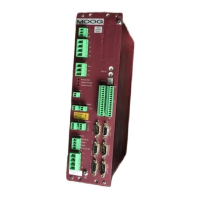T200 User's Manual SECTION 2: SAFETY INSTRUCTIONS
PAGE 2-12
Connections to devices mounted on doors or to other movable parts shall be made using flexible conductors in
accordance with European standard EN 60204-1, to allow for the frequent movement of the part. The conductors shall
be anchored to the fixed part and the movable part independently of the electrical connections.
Conductors and cables that do not run in ducts shall be adequately supported.
Terminal blocks or attachment plug/socket combinations shall be used for control wiring that extends beyond the
enclosure.
Power cables and cables of measuring circuits may be directly connected to the terminals of the devices for which the
connections were intended.
i) Wiring Practices - Wiring outside enclosures
The means of introduction of cables or ducts with their individual glands, bushings, etc., into an enclosure shall ensure
that the degree of protection is not reduced.
Conductors and their connections external to the electrical equipment IP54 enclosures shall be installed in suitable ducts
(i.e. conduit or cable trunking systems) as described in Section 2.3.4, except for suitably protected cables, which may be
installed without enclosing ducts and with or without the use of open cable trays or cable support means.
Fittings used with ducts or multi-conductor cable shall be suitable for the physical environment.
Flexible conduit or flexible multi-conductor cable shall be used where it is necessary to employ flexible connections to
pendant push-button stations. The weight of pendant stations shall be supported by means other than the flexible conduit
or the flexible multi-conductor cable, except where the conduit or cable is specifically designed for that purpose.
Flexible conduit or flexible multi-conductor cable shall be used for connections involving small or infrequent
movements. They shall also be permitted to complete the connection to normally stationary motors, to position switches,
and to other externally mounted devices.
Connections to frequently moving parts shall be made with conductors suitable for flexing service in accordance with
European standard EN 60204-1. Flexible cable and flexible conduit shall be so installed as to avoid excessive flexing
and straining particularly at the fittings.
Cables subject to movement shall be supported in such a way that there is no mechanical strain on the connection points
nor any sharp bending. The loop shall have sufficient length to provide for a bending radius of the cable of at least ten
times its outside diameter.
Where cables subject to movement are close to moving parts, precautions shall be taken so that a space of at least 25mm
shall be maintained between the moving parts and the cables. Where this distance is not practicable, fixed barriers shall
be provided between the cables and the moving parts.
The cable sheath shall be resistant to the normal wear which can be expected from movement, and to the effects of
atmospheric contaminants (e.g. oil, water, coolants, dust).
Where flexible conduit is adjacent to moving parts, the construction and supporting means shall prevent damage to the
flexible conduit or cable under all conditions of operation.
Flexible metal conduit shall not be used for rapid or frequent movements, except when specifically designed for that
purpose.
Artisan Technology Group - Quality Instrumentation ... Guaranteed | (888) 88-SOURCE | www.artisantg.com

